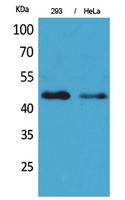IDH1 Polyclonal Antibody
- Catalog No.:YT5416
- Applications:WB;IHC;IF;ELISA
- Reactivity:Human;Mouse;Rat
- Target:
- IDH1
- Fields:
- >>Citrate cycle (TCA cycle);>>Glutathione metabolism;>>Metabolic pathways;>>Carbon metabolism;>>2-Oxocarboxylic acid metabolism;>>Biosynthesis of amino acids;>>Peroxisome;>>Central carbon metabolism in cancer
- Gene Name:
- IDH1
- Protein Name:
- Isocitrate dehydrogenase [NADP] cytoplasmic
- Human Gene Id:
- 3417
- Human Swiss Prot No:
- O75874
- Mouse Gene Id:
- 15926
- Mouse Swiss Prot No:
- O88844
- Rat Gene Id:
- 24479
- Rat Swiss Prot No:
- P41562
- Immunogen:
- Synthesized peptide derived from the N-terminal region of human IDH1.
- Specificity:
- IDH1 Polyclonal Antibody detects endogenous levels of IDH1 protein.
- Formulation:
- Liquid in PBS containing 50% glycerol, 0.5% BSA and 0.02% sodium azide.
- Source:
- Polyclonal, Rabbit,IgG
- Dilution:
- WB 1:500 - 1:2000. IHC: 1:100-1:300. ELISA: 1:20000.. IF 1:50-200
- Purification:
- The antibody was affinity-purified from rabbit antiserum by affinity-chromatography using epitope-specific immunogen.
- Concentration:
- 1 mg/ml
- Storage Stability:
- -15°C to -25°C/1 year(Do not lower than -25°C)
- Other Name:
- IDH1;PICD;Isocitrate dehydrogenase [NADP] cytoplasmic;IDH;Cytosolic NADP-isocitrate dehydrogenase;IDP;NADP(+)-specific ICDH;Oxalosuccinate decarboxylase
- Observed Band(KD):
- 46kD
- Background:
- Isocitrate dehydrogenases catalyze the oxidative decarboxylation of isocitrate to 2-oxoglutarate. These enzymes belong to two distinct subclasses, one of which utilizes NAD(+) as the electron acceptor and the other NADP(+). Five isocitrate dehydrogenases have been reported: three NAD(+)-dependent isocitrate dehydrogenases, which localize to the mitochondrial matrix, and two NADP(+)-dependent isocitrate dehydrogenases, one of which is mitochondrial and the other predominantly cytosolic. Each NADP(+)-dependent isozyme is a homodimer. The protein encoded by this gene is the NADP(+)-dependent isocitrate dehydrogenase found in the cytoplasm and peroxisomes. It contains the PTS-1 peroxisomal targeting signal sequence. The presence of this enzyme in peroxisomes suggests roles in the regeneration of NADPH for intraperoxisomal reductions, such as the conversion of 2, 4-dienoyl-CoAs to
- Function:
- catalytic activity:Isocitrate + NADP(+) = 2-oxoglutarate + CO(2) + NADPH.,catalytic activity:Oxalosuccinate + NADP(+) = 2-oxoglutarate + CO(2) + NADPH.,cofactor:Binds 1 magnesium or manganese ion per subunit.,disease:Defects in IDH1 are a cause of glioblastoma multiforme (GBM) [MIM:137800]; also called familial glioma of brain. Gliomas are central nervous system neoplasms derived from glial cells and comprise astrocytomas, glioblastoma multiforme, oligodendrogliomas, and ependymomas.,miscellaneous:Cancer mutations affecting Arg-132 are tissue-specific, and suggest that this residue plays a unique role in the development of high-grade gliomas.,online information:Isocitrate dehydrogenase entry,similarity:Belongs to the isocitrate and isopropylmalate dehydrogenases family.,subunit:Homodimer.,
- Subcellular Location:
- Cytoplasm, cytosol . Peroxisome .
- Expression:
- Brain,Cajal-Retzius cell,Fetal brain cortex,Human endometri
- June 19-2018
- WESTERN IMMUNOBLOTTING PROTOCOL
- June 19-2018
- IMMUNOHISTOCHEMISTRY-PARAFFIN PROTOCOL
- June 19-2018
- IMMUNOFLUORESCENCE PROTOCOL
- September 08-2020
- FLOW-CYTOMEYRT-PROTOCOL
- May 20-2022
- Cell-Based ELISA│解您多样本WB检测之困扰
- July 13-2018
- CELL-BASED-ELISA-PROTOCOL-FOR-ACETYL-PROTEIN
- July 13-2018
- CELL-BASED-ELISA-PROTOCOL-FOR-PHOSPHO-PROTEIN
- July 13-2018
- Antibody-FAQs
- Products Images

- Western Blot analysis of 293, HeLa cells using IDH1 Polyclonal Antibody. Secondary antibody(catalog#:RS0002) was diluted at 1:20000

- Immunohistochemical analysis of paraffin-embedded human-lung, antibody was diluted at 1:100

- Immunohistochemical analysis of paraffin-embedded human-kidney, antibody was diluted at 1:100



